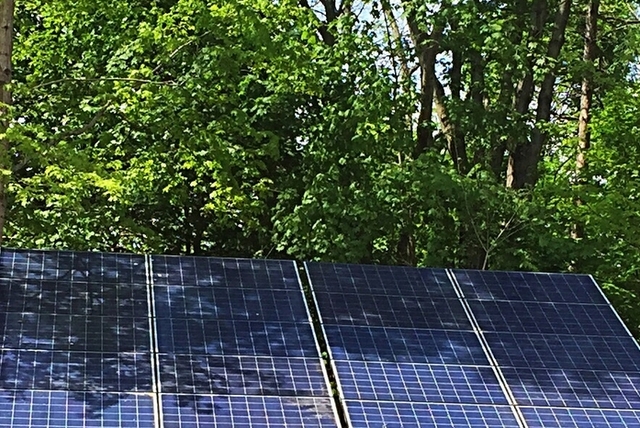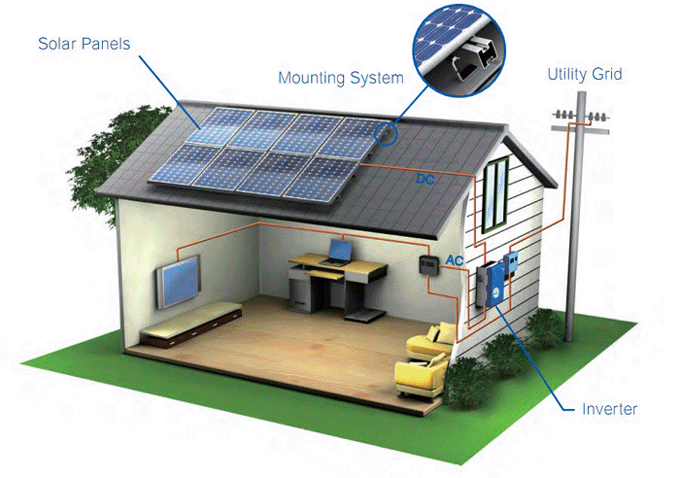Solar Power Blog

How much power do solar panels produce?
If you have been searching all around the internet to understand how much power solar panels can produce, there is a reason why an easy, singular answer to this question is difficult to find.
In reality, there are nearly a dozen different factors that dictate how much power a solar panel can produce at any moment in time, over the course of a day, or throughout its entire lifespan.
Below, we will break down solar power piece by piece to explain everything you need to know about solar electricity generation, before sharing the tools you can use to calculate your panels’ potential solar production.
Factors that Influence Solar Power Production
Internal, external, natural, and man-made – let’s take a look at all of the real-world factors that influence how much power a solar panel can produce.
Sunlight Intensity (or Irradiance)
By definition, new solar power generation is completely dependent on the amount of potential solar energy that your panels can receive. In other words, the potential power production of an electricity-generating photovoltaic (PV) system is based on the intensity of the sunlight (commonly known as the irradiance) shining on your solar panels.

While solar panels cannot produce any electricity whatsoever when there is no solar irradiance (such as at night), they can generate the most electricity with direct sunlight. Throughout the course of a day, sunlight intensity or irradiance is usually at its highest during what are known as “peak sun hours.”
Although marginal amounts of electricity can be produced during “off-peak” hours (when the sunlight is less direct), the majority of solar power generation takes place during a 4 to 6 hour window in the middle of the day. The amount of peak sunlight hours on any given day varies throughout the year and is largely dependent on geographic location and local weather conditions.
Solar Panel Wattage
Within the wide world of solar panel options, there are many different products on the market with varying capabilities. Before you purchase any particular solar panel, be sure to check its wattage rating to best understand the amount of power it will be able to produce.
A solar panel’s wattage rating relates to the amount of power it could potentially output in ideal operating conditions. As electricity is measured in watt-hours (Wh), a 100-watt solar panel would then be able to theoretically produce 100 watt-hours of solar power over the course of a single hour, just as a 300W panel could produce 300 watt-hours in one hour.
Solar Cell Efficiency
In addition to wattage, the efficiency of your solar panels will also play a large role in determining how much power can be generated at any moment in time. While solar efficiencies vary between products, in general, higher efficiency products are going to be higher quality and more expensive upfront.
Over the course of your solar panel's lifetime, its efficiency will slowly depreciate until it is no longer producing significant amounts of electricity. When looking at the top-tier solar panels installed on homes today, most equipment is rated to maintain at least 80% of its solar production efficiency through 20 years of operation or more.
Panel Placement
Precisely where you install your solar panels will also dramatically affect the amount of solar power your system can produce. As most solar panels are mounted to a fixed location throughout the duration of their lifetime, picking the optimal placement for your array is very important to maximize your power production.
In the United States, the ideal placement of a solar panel is south-facing at an angle between 30° and 45°. While east and west-facing panels can still generate significant amounts of solar power, southern-facing panels are optimal, as they can capture as much daily sunlight as possible during peak sun hours.
Shading
If a solar panel's best friend is the sun, then its worse enemy is the shade. Even if only exposed to a little bit of shade, a partially-shaded solar panel will begin to produce significantly less energy than its total potential output. For this reason, minimizing potential shade on your panels should be one of the leading priorities of your solar installation.

Shade on solar panels can be caused by many things, the most common of which are neighboring trees, chimneys, and build-ups of dust, dirt, and debris. Therefore, in addition to positioning your solar panels so that they can receive full sunlight away from any shade obstructions, cleaning and maintaining your system is the best way to ensure the maximum amount of direct sunlight can be harnessed.
Temperature
While generating emission-free power, outside temperatures will also affect how efficiently a solar panel can capture sunlight and produce usable electricity. Like a lot of technology (such as computers and phones), solar panels actually prefer cooler conditions over hotter outside temperatures.
Therefore, most solar panels surprisingly work most efficiently in colder climates. With that being said, there are also many solar panels manufactured specifically to maintain operational efficiency in hotter temperatures that are more suitable for warm areas.
Other System Components
Outside of the solar panels themselves, a typical solar energy system consists of several other components that will affect its overall efficiency. With the exception of basic solar chargers and other small closed circuits, solar power is usually processed through a series of wires and an inverter (or multiple microinverters) before it can be used to power your home and electronics.

As a result, in larger solar energy installations, the amount of usable power that your solar panels will be able to produce will be directly affected by the efficiency of your inverter, the gauge of your wiring, and the quality of your other system components.
Solar Panel Production Calculator
With all these factors in mind, calculating the amount of electricity a solar panel can produce at any moment in time is a difficult task. Thankfully, there are a number of resources that you can use to gain an approximate estimate of your solar panels’ expected monthly and annual production.
Using the PVWatts Calculator from the National Renewable Energy Laboratory, you can calculate your potential solar power production using your address and installation details. When inputting the capacity of your system, keep in mind that 1 kilowatt (kW) is equal to 1,000 watts, and that panel wattages add up with one another. Therefore, if you design a three 100-watt solar panel system, this would equate to a total capacity of 300 watts or 0.3 kW.
Want to learn more?
Read our Solar FAQs or learn more in the Solar Us Shop blog.

